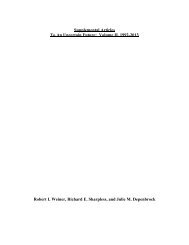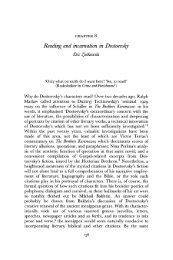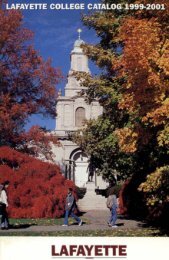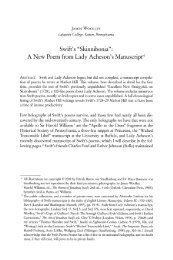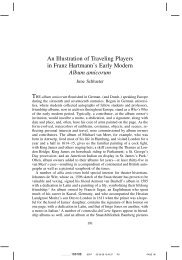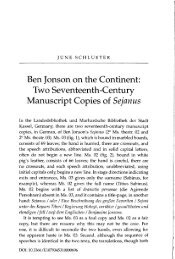Between Religion and Literature: Mircea Eliade ... - Lafayette College
Between Religion and Literature: Mircea Eliade ... - Lafayette College
Between Religion and Literature: Mircea Eliade ... - Lafayette College
You also want an ePaper? Increase the reach of your titles
YUMPU automatically turns print PDFs into web optimized ePapers that Google loves.
<strong>Eliade</strong> <strong>and</strong> Frye<br />
"entertainment" tradition, the so-called "Secular Scripture," which is<br />
characteristic of Spenser, Scott, <strong>and</strong> Morris, as well as Chaucer <strong>and</strong><br />
Shakespeare, finds its roots in fable <strong>and</strong> folktale.'24 Frye differs from<br />
<strong>Eliade</strong> insofar as he confines his scope almost exclusively to Western literature<br />
<strong>and</strong> places such great weight on the Bible, which, as Blake revealed,<br />
has a "mythological structure" that exp<strong>and</strong>ed into a "mythological universe."25<br />
Nonetheless, the complementariness of Frye's theory of displacement<br />
<strong>and</strong> <strong>Eliade</strong>'s morphology of the sacred finds illustration when<br />
the latter's surveys of myths, symbols, <strong>and</strong> rituals of ascension <strong>and</strong> descent<br />
in religions around the world126 are considered in the light of the former's<br />
concept of the "four primary narrative movements" of which all stories in<br />
literature are "complications" or "metaphorical derivations": descent<br />
from a higher world; descent to a lower world; ascent from a lower world;<br />
ascent to a higher world.'27 Indeed, Frye's indebtedness to <strong>Eliade</strong> is<br />
nowhere more apparent than in his final book's lengthy discussion of<br />
the image of the axis mundi or vertical dimension of the cosmos in literature,'28<br />
an image whose countless variations in the cosmologies of the<br />
world was revealed by <strong>Eliade</strong>.<br />
VI<br />
Together with <strong>Eliade</strong>'s passing (1986), <strong>and</strong> perhaps that of Joseph<br />
Campbell (1987) as well, Frye's death earlier this year may be said to mark<br />
the final closure of a trend of thought that flourished in the study of religion,<br />
myth, <strong>and</strong> literature during the 1950s <strong>and</strong> 1960s, quite apart from<br />
the developing field of "theology <strong>and</strong> literature" that later evolved into<br />
"religion <strong>and</strong> literature." While, as we have seen, <strong>Eliade</strong> <strong>and</strong> Frye construed<br />
their young disciplines as theoretically <strong>and</strong> methodologically<br />
autonomous, the two scholars shared in their leaning toward universalism,<br />
totality, integration, synthesis, <strong>and</strong> transhistoricism. Yet both<br />
were aware that they represented a waning trend, an ironic concession in<br />
the light of the increased confidence of physical <strong>and</strong> life scientists<br />
approaching a gr<strong>and</strong> theory unifying nature. <strong>Eliade</strong> observed in 1964 that<br />
his generation <strong>and</strong> its followers no longer took stock in "systematic<br />
124 See Frye, Secular Scripture (n. 31 above), p. 6.<br />
125 Frye, Spiritus Mundi, p. 108; cf. p. 17. This, of course, is the insight that underlies Frye's<br />
full-length studies of the Bible <strong>and</strong> literature, The Great Code <strong>and</strong> Words with Power.<br />
26 See, e.g., <strong>Mircea</strong> <strong>Eliade</strong>, Patterns, pp. 102-8, Myths, Dreams <strong>and</strong> Mysteries (n. 112 above),<br />
chap. 5. See also the intermittent discussions of ascent smbolism, mystical flight, levitation,<br />
descensus ad inferos, journey to the underworld, etc., in <strong>Eliade</strong>'s Yoga (n. 1 above), <strong>and</strong> Shamanism:<br />
Archaic Techniques ofEcstasy, trans. Willard R. Trask (Princeton, N.J.: Princeton University Press,<br />
1972).<br />
127 Frye, Secular Scripture (n. 31 above), p. 97.<br />
'28 See Frye, Words with Power (n. 22 above), pp. 95, 151-87, 194, 232, 276, 288.<br />
519



